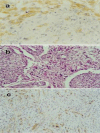Secondary gliosarcoma after the treatment of primary glioblastoma multiforme
- PMID: 22361502
- PMCID: PMC3271412
- DOI: 10.4297/najms.2011.3527
Secondary gliosarcoma after the treatment of primary glioblastoma multiforme
Abstract
Context: Gliosarcoma is a rare variant of glioblastoma multiforme containing distinct gliomatous and sarcomatous components. Gliosarcoma comprise 1.8-8% of glioblastoma multiforme and are clinically similar to them, affecting adults in the fourth and sixth decades of life, with a higher proportion found in males. The survival for patients with Gliosarcoma is equally poor as for those with glioblastoma multiforme, and there is a greater propensity for extracranial metastasis in Gliosarcoma. Clinical treatment-related experience reported in the literature is limited, and Gliosarcoma are currently treated in a similar fashion to glioblastoma multiforme, with modalities including tumor resection, postoperative radiation therapy, and chemotherapy. Gliosarcoma can arise secondarily, after conventional adjuvant treatment of high-grade glioma. The current literature on the occurrence of secondary gliosarcoma after glioblastoma multiforme is limited, with only 54 reported cases.
Case report: The authors present a 48-year-old Caucasian male who had previously received postoperative combined radiation and temozolomide chemotherapy for glioblastoma multiforme. After a free disease period of 9 months the disease recurs as Gliosarcoma. The patient underwent a Total surgical excision and received chemotherapy with a basis of bevacizumab and irinotecan. The patient died from tumor progression 5 months after gliosarcoma diagnosis.
Conclusion: The poor survival of patients with secondary gliosarcoma who had previously received combined radiation and temozolomide chemotherapy for glioblastoma multiforme may reflect a unique molecular profile of glioblastoma multiforme that eventually recurs as secondary gliosarcoma. We have to keep in mind the possibility of gliosarcomatous change in the recurrence of malignant glioma. Awareness of this pathological entity will allow more rapid diagnosis and treatment.
Keywords: High-grade glioma; chemotherapy; glioblastoma multiforme; radiotherapy; secondary gliosarcoma; tumor resection.
Figures


References
-
- Stroebe H. Ueber Entstehung und Bau der Gehirngliome. Beitr Pathol Anat. 1895;18:405–486.
-
- Cheong J-H, Kim C-H, Kimand J-M, Oh Y-M. Transformation of intracranial anaplastic astrocytoma associated with neurofibromatosis type I into gliosarcoma: Case report. Clin Neurol Neuroserg. 2010;112(8):701–706. - PubMed
-
- Han SJ, Yang I, Tihan T, Chang SM, Parsa AT. Secondary gliosarcoma: a review of clinical features and pathologic diagnosis. J Neurosurg. 2010;112:26–32. - PubMed
-
- Alatakis S, Stuckey S, Siu K, McLean C. Gliosarcoma with osteosarcomatous differentiation: review of radiological and pathological features. J Clin Neurosci. 2004;11(6):650–656. - PubMed
Publication types
LinkOut - more resources
Full Text Sources

